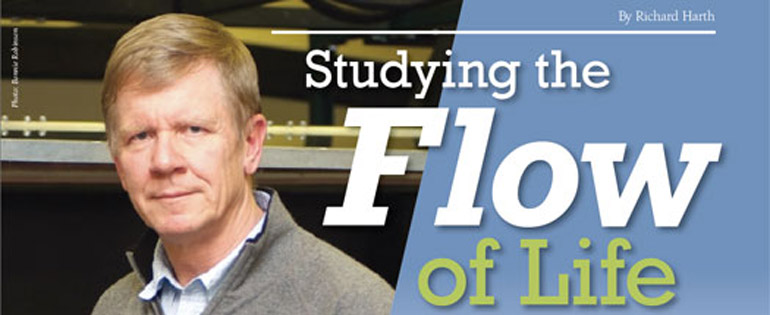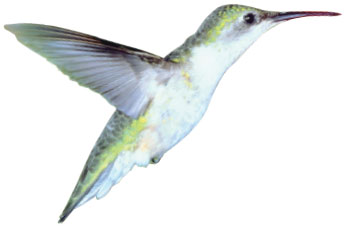
On a typical summer day, colorful sailboats stream across Lake Michigan, their graceful bows neatly carving the water. For many enjoying the afternoon, the gusts and currents of air filling the sails, the curling eddies of water developing in the boats’ wake, are incidental to the relaxation and pleasure of sailing.
For IIT’s David Williams, however, the behavior of these liquids and gases in motion is a source of fascination. As a professor of fluid mechanics, Williams studies the dynamics of fluid flow, using mathematical models to better understand complex phenomena. Such research helps him design new ways to modify fluid performance to suit a multiplicity of human needs. Williams’ chosen field is also well suited to his twin recreational passions: competitive sailboat racing and piloting small airplanes.
A devotion to sailing began early. “I built my first sailboat when I was 15,” Williams recalls. Noting some errors in the original plan designs, the youngster made a few modifications. “I fixed it and it sailed fine. I ended up selling that boat after about a year and buying my first racing boat when I was 16.”
Thus began a 40-year romance with the sport of sailboat racing. So far, Williams has been in three Olympic sailing trials and recently qualified for the World Sailing Championships, to be held in Chicago this June.
Williams’ fascination with flight also dates from his childhood. “I grew up on an Air Force base and have always been interested in airplanes,” he remembers. “In the ’60s there was a lot of excitement about high-speed planes and rockets. I wrote to NASA in fifth grade, asking for information on the X-15 project, and they sent me a big brown folder full of reports and tons of information. That made a big impression on me.”
It wasn’t surprising that Williams’ boyhood infatuation with boats and airplanes (and the currents of water and air they ride on) stimulated a deep, scientific curiosity. Intrigued by the study of fluid flow, Williams eventually earned both master’s and doctorate degrees in fluid dynamics from Princeton University.
At IIT, research on such diverse areas as unsteady aerodynamics, fluid-structure interaction, turbulence, hydrodynamic stability, and aeroacoustics is carried out through the Fluid Dynamics Research Center (FDRC), part of the Department of Mechanical, Materials, and Aerospace Engineering. The department’s state-of-the-art facilities have been selected as among three National Centers of Excellence by the U.S. Air Force Office of Scientific Research.
The National Diagnostic Facility, a large wind tunnel with exceptionally high flow qualities, complements other wind tunnels, water channels, and compressor facilities, and possesses formidable computing capabilities. Using FDRC’s unsteady flow wind tunnel, for example, Williams is able to carry out real-time simulations of wings in flight.
“Through computer control, we can measure the forces on the wings. We can reproduce how an airplane can fly in the tunnel,” he explains, adding, “You’re not just holding the model in a fixed position; it’s actually going up and down, and pitching.”
Birds and Bees
A crucial area of Williams’ research concerns the efficiency and maneuverability of wings in flight. Such cutting-edge research draws on meticulous examinations of what our insect and avian relatives have been up to for millions of years. This new approach to aeronautic design is sometimes referred to as bio-inspired flight. Williams is pursuing research with participants from California Institute of Technology, Princeton, and Northeastern Universityin Boston.
Pondering creatures such as dragonflies, hummingbirds, and other master fliers, Williams observes, “The real question is how these things can fly at all.” On a recent trip to Pennsylvania, he was captivated by one peculiar specimen, a hovering, hand-sized bird that locals have dubbed the ‘helicopter bird.’ “It caught my attention because it appeared to be perfectly stationary and wasn’t flapping its wings with any noticeable amplitude. You couldn’t build a model airplane of the same size to do that. It was just incredible.”
One of the ways that both birds and insects achieve superlative flight performance is through their ability to generate so-called leading edge vortices. The flight of the Common Swift, for example, has been studied in considerable detail, Williams says. Swifts use their remarkable aerial dexterity to snatch insects in mid-air. Their ability has to do with the Swift’s two-part wing design, consisting of a shorter ‘arm wing,’ similar to the wing of a conventional airplane, and a longer, swept back ‘hand wing,’ which is flatter on top, angles toward the rear, and is much sharper, like the wing of a fighter jet.

Swifts use their arm wings to generate the leading edge vortices—low pressure zones that create lift. By subtly modifying wing angle, Swifts and other acrobatic birds can alter the ratio of lift to drag, permitting extreme mid-air maneuverability.
If some of nature’s avian secrets can be applied to human designs, Williams suggests, a new class of startlingly nimble aircraft will emerge. Further, some of these will fit comfortably in the palm of a hand. Known as micro air vehicles, such cyber-birds and insects could be used for a variety of tasks, including search and rescue operations, aerial surveillance, or biological agent detection.
Williams’ own airborne adventures began eight years ago. “I teach the junior-level aerodynamics class,” he explains. “A friend at Princeton told me he took his students to the airport for intro flights, where they’d get to fly a Cessna 172 for half an hour with an instructor. I thought that was a good idea for our students.” So Williams learned to fly, beginning with single-engine planes like the Piper Arrow, graduating more recently to a Beach Baron twin engine.
Before long, Williams was hooked. With the help of former IIT student Jerome Chiecchio (AE ’01), he began ferrying planes to buyers in the U.S. and overseas. One memorable trip brought the pair to Riga, Latvia via Bangor, Maine; Goose Bay, Canada; Greenland; Iceland; Scotland; and Denmark during the course of a six-day odyssey in 2006.
Current Affairs
These days, Williams would more likely be spotted in the water than in the air, however, as he eagerly prepares for the World Sailing Championships. Williams and his two team members will race a 30-foot “One-Design” sailboat in the Etchells Class. One-Designs are built specifically for racing and must conform to rigid hull specifications.
Despite this, Williams insists, all boats are not created equal, and newer boats tend to be faster. Williams claims the formula for success relies 60–70 percent on the quality of the team and about 30–40 percent on the boat. His own team includes two of Williams’ longtime sailing companions. “We do each other’s jobs simultaneously. There’s a lot of discussion on the boat between us about what we should do next during the race,” he says.
Presently, the three are honing their tactics by studying a rival Chicago contender for the Worlds trophy. “This guy did very well at the national championships—he’s significantly faster than us,” Williams says, adding, “We’re researching what he’s doing that’s different and gives him a little bit of an edge.”
When it comes to the art of sailboat racing, Williams tends to downplay his scientific knowledge. “I have an understanding of what the flow is doing over the sails, but it really doesn’t help. The difference between first place and fifth place in a typical race is about 1 percent in performance. I can’t tell you on the basis of my knowledge of fluid dynamics or of airfoils what changes would give you that 1 percent. It’s kind of trial and error, based on experience of the racecourse.”
Lately, Williams is vigorously rehearsing for race day whenever his teaching and research schedules allow. “We’ll sail unless there’s ice in the harbor. We’ll begin again in March.” While a first-place finish at the Worlds would surely electrify the team, Williams is gratified for the opportunity to compete in such a prestigious event. “A lot of former Olympic and America’s Cup sailors race these boats, so it’s really good competition at the top levels,” he says.
“You have to have a first-rate boat, first-rate sails, and a first-rate team. Those are the three essentials to win the World Championships.”